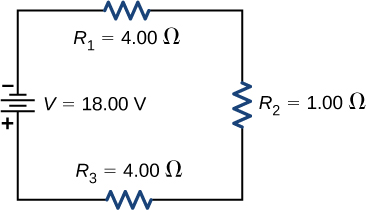| << Chapter < Page | Chapter >> Page > |
A voltage occurs across an open switch. What is the power dissipated by the open switch?
The severity of a shock depends on the magnitude of the current through your body. Would you prefer to be in series or in parallel with a resistance, such as the heating element of a toaster, if you were shocked by it? Explain.
It would probably be better to be in series because the current will be less than if it were in parallel.
Suppose you are doing a physics lab that asks you to put a resistor into a circuit, but all the resistors supplied have a larger resistance than the requested value. How would you connect the available resistances to attempt to get the smaller value asked for?
Some light bulbs have three power settings (not including zero), obtained from multiple filaments that are individually switched and wired in parallel. What is the minimum number of filaments needed for three power settings?
two filaments, a low resistance and a high resistance, connected in parallel
(a) What is the resistance of a , a , and a resistor connected in series? (b) In parallel?
What are the largest and smallest resistances you can obtain by connecting a , a , and a resistor together?
largest, , smallest,
An 1800-W toaster, a 1400-W speaker, and a 75-W lamp are plugged into the same outlet in a 15-A fuse and 120-V circuit. (The three devices are in parallel when plugged into the same socket.) (a) What current is drawn by each device? (b) Will this combination blow the 15-A fuse?
Your car’s 30.0-W headlight and 2.40-kW starter are ordinarily connected in parallel in a 12.0-V system. What power would one headlight and the starter consume if connected in series to a 12.0-V battery? (Neglect any other resistance in the circuit and any change in resistance in the two devices.)
29.6 W
(a) Given a 48.0-V battery and and resistors, find the current and power for each when connected in series. (b) Repeat when the resistances are in parallel.
Referring to the example combining series and parallel circuits and [link] , calculate in the following two different ways: (a) from the known values of and ; (b) using Ohm’s law for . In both parts, explicitly show how you follow the steps in the [link] .
a. 0.74 A; b. 0.742 A
Referring to [link] , (a) Calculate and note how it compares with found in the first two example problems in this module. (b) Find the total power supplied by the source and compare it with the sum of the powers dissipated by the resistors.
Refer to [link] and the discussion of lights dimming when a heavy appliance comes on. (a) Given the voltage source is 120 V, the wire resistance is and the bulb is nominally 75.0 W, what power will the bulb dissipate if a total of 15.0 A passes through the wires when the motor comes on? Assume negligible change in bulb resistance. (b) What power is consumed by the motor?
a. 60.8 W; b. 3.18 kW
Show that if two resistors and are combined and one is much greater than the other , (a) their series resistance is very nearly equal to the greater resistance and (b) their parallel resistance is very nearly equal to smaller resistance .
Consider the circuit shown below. The terminal voltage of the battery is (a) Find the equivalent resistance of the circuit. (b) Find the current through each resistor. (c) Find the potential drop across each resistor. (d) Find the power dissipated by each resistor. (e) Find the power supplied by the battery.

a.
; b.
;
c.
; d.
; e.

Notification Switch
Would you like to follow the 'University physics volume 2' conversation and receive update notifications?